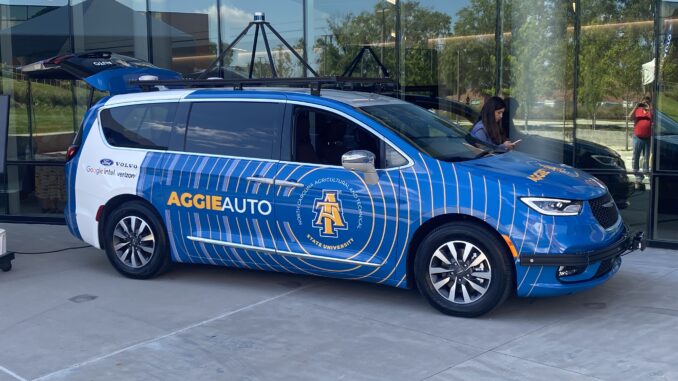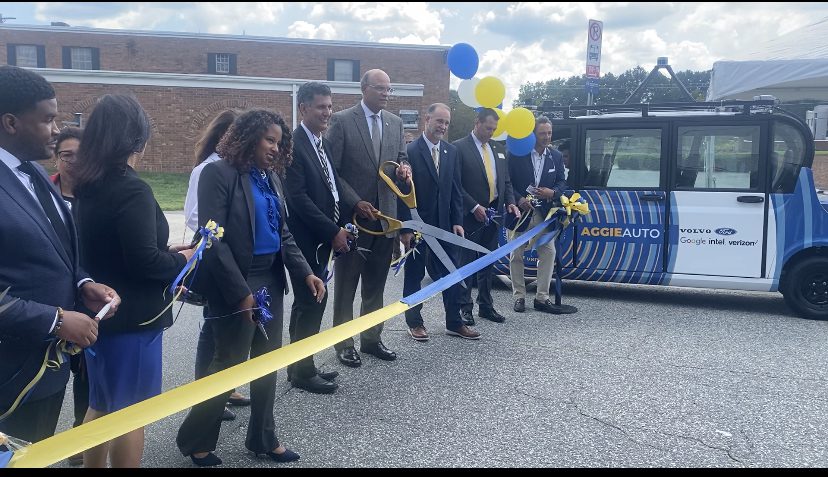
GREENSBORO — While politicians and government officials like to create jobs, Greensboro mayor Nancy Vaughan’s ride from city hall to NC A&T on Monday was memorable because of the job that had been eliminated—her driver.
Vaughan was one of the first passengers to test out the fleet of driverless shuttles NC A&T is using to connect campus to downtown, about a mile away.
“I must admit, taking a spin on the autonomous vehicle as it transported me from City Hall to this building was unlike anything I’ve ever experienced,” Vaughan said at a ribbon cutting ceremony at the school’s Harold L. Martin Sr. Engineering Research and Innovation Complex.
“It reminded me of the Jetsons,” she added.

Three autonomous shuttles, or Aggie Autos, will make the round trip from the Martin Engineering building to the Miriam P. Brenner Children’s Museum. The vehicles seat up to five passengers and use a combination of GPS and LIDAR (Light detection and ranging) to navigate traffic and sense potential obstacles. They can reach a maximum speed of 25 mph, and the A&T team that developed the project also produced an app that allows potential riders to track the vehicles as they make their trips.
The fleet also includes a self-driving van that can reach higher speeds, as well as two autonomous sedans.
The autonomous cars, which are available for members of the public to try out from 11:00 AM to 1:00 PM each weekday for the next month, as the development team collects feedback on the experience, allow members of the A&T campus community to make use of the city’s downtown conveniences, eliminating what has become a food desert around the school.
“This advances our connectivity, providing another transit option for our residents, particularly for college students to connect to downtown,” Mayor Vaughan said. “The benefits of autonomous vehicles are numerous as they enhance mobility options increased productivity as drivers recover time in their day. To support sustainability by reducing fuel and carbon emissions and the vehicles make the overall transportation system safer.”
As school and local government officials prepared for the ribbon cutting to set the driverless cars loose on the roads, the tiny six-wheeled food delivery robots the school has been using for more than two years cris-crossed on the sidewalks around the engineering building, yet another reminder of the work A&T is doing to incorporate cutting-edge technology in campus life.
“The launch of this new autonomous shuttle between our campus and downtown Greensboro is the latest example of the exciting and innovative research of our faculty and students at North Carolina A&T,” said Chancellor Harold L. Martin Sr. “This research represents more tangible evidence of how the university realizes its mission of improving the human condition and facilitating economic growth in North Carolina and beyond. Developing groundbreaking, equitable and efficient transportation solutions enhances the quality of life for all in our communities, especially those in underserved areas
The ride
Mayor Vaughan was right. The ride is reminiscent of the Jetsons, particularly the burbling hum the vehicles make. For the initial rollout, each shuttle will have a graduate student in the driver’s seat, ready to take over in case there are any unforeseen glitches.
One occurs right as the vehicle pulls away from the curb. The crowd gathered to watch the maiden driverless trips steps to the curb, cell phones in hand, to record the moment. This seems to confuse the vehicle, which appears to interpret the group movement as a potential obstacle, about to enter the roadway. The vehicle stops, then starts, then stops again. The grad student presses a button to disengage the autopilot and gets the car moving, then turns the driverless function back on. As we pull away, he raises his hands and waves them in the air, demonstrating to all that he’s no longer in control.
The vehicle hums along—as many first-time riders point out, 25 mph is much faster than one would think. It comes to a stop sign and obeys. The in-car video screen displays the “stop line” on the street, in front of the sign. The car is able to find a gap in the traffic, which has been stopped by a police officer providing a human assistance on Day One, and makes a right turn.
When the car reaches a red light, the grad student again takes over. He cryptically explains that they’ve disengaged the functionality that deals with traffic lights. “The driver has to take over,” he says, with no further information about why or whether this is a temporary situation or will be ongoing.
The car is able to navigate other obstacles, such as a stopped vehicle in its lane.
It’s much like riding with a 16-year-old on their permit. The driving is slow and cautious, with the occasional overreaction. We cut left, then right to move around a small object in the lane that we could have rolled over without incident. We also come to near complete stops on right turns, creeping carefully into the new lane.
The vehicle pulls into the designated drop off spot at the museum, nearly clipping one of the blue traffic poles demarcating the space. The grad student gives the wheel a quick turn to make sure we miss it. Then it’s back to campus, and the future.



